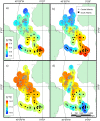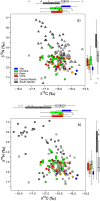Using marine isoscapes to infer movements of oceanic migrants: The case of Bulwer's petrel, Bulweria bulwerii, in the Atlantic Ocean
- PMID: 29894489
- PMCID: PMC5997309
- DOI: 10.1371/journal.pone.0198667
Using marine isoscapes to infer movements of oceanic migrants: The case of Bulwer's petrel, Bulweria bulwerii, in the Atlantic Ocean
Erratum in
-
Correction: Using marine isoscapes to infer movements of oceanic migrants: The case of Bulwer's petrel, Bulweria bulwerii, in the Atlantic Ocean.PLoS One. 2019 Mar 5;14(3):e0213565. doi: 10.1371/journal.pone.0213565. eCollection 2019. PLoS One. 2019. PMID: 30835772 Free PMC article.
Abstract
Studying the movements of oceanic migrants has been elusive until the advent of several tracking devices, such as the light-level geolocators. Stable isotope analysis (SIA) offers a complementary approach to infer areas used year-round, but its suitability in oceanic environments remains almost unexplored. To evaluate SIA as a tool for inferring movements of oceanic migrants, we sampled an oceanic seabird, the Bulwer's petrel, Bulweria bulwerii, in four breeding colonies spread along its Atlantic distribution. We first studied the species moulting pattern from 29 corpses collected in the colonies. Secondly, based on this moult knowledge, we selected three feathers from tracked birds to infer their breeding and non-breeding grounds using SIA: the 1st primary (P1), the 8th secondary (S8) and the 6th rectrix (R6) feathers. Birds migrated to two main non-breeding areas, the Central or the South Atlantic Ocean. P1 showed similar isotopic values among petrels from different breeding colonies, suggesting this feather is replaced early in the non-breeding period in a common area used by most birds, the Central Atlantic. S8 and R6 feathers correctly assigned 92% and 81%, respectively, of the birds to their non-breeding areas, suggesting they were replaced late in season, when birds were settled in their main non-breeding grounds. Our results showed that the isotopic baseline levels of the Central and South Atlantic are propagated through the food web until reaching top predators, suggesting these ratios can be used to infer the movement of long-distance migrants among oceanic water masses.
Conflict of interest statement
The authors have declared that no competing interests exist.
Figures


Similar articles
-
Correction: Using marine isoscapes to infer movements of oceanic migrants: The case of Bulwer's petrel, Bulweria bulwerii, in the Atlantic Ocean.PLoS One. 2019 Mar 5;14(3):e0213565. doi: 10.1371/journal.pone.0213565. eCollection 2019. PLoS One. 2019. PMID: 30835772 Free PMC article.
-
Monitoring of mercury in the mesopelagic domain of the Pacific and Atlantic oceans using body feathers of Bulwer's petrel as a bioindicator.Sci Total Environ. 2021 Jun 25;775:145796. doi: 10.1016/j.scitotenv.2021.145796. Epub 2021 Feb 12. Sci Total Environ. 2021. PMID: 33618310
-
Linking isotopic and migratory patterns in a pelagic seabird.Oecologia. 2009 May;160(1):97-105. doi: 10.1007/s00442-008-1273-x. Epub 2009 Feb 5. Oecologia. 2009. PMID: 19194727
-
Contrasting patterns of population structure of Bulwer's petrel (Bulweria bulwerii) between oceans revealed by statistical phylogeography.Sci Rep. 2023 Feb 2;13(1):1939. doi: 10.1038/s41598-023-28452-z. Sci Rep. 2023. PMID: 36732530 Free PMC article.
-
Evidence for overlooked mechanisms of long-distance seed dispersal to and between oceanic islands.New Phytol. 2012 Apr;194(2):313-317. doi: 10.1111/j.1469-8137.2011.04051.x. Epub 2012 Jan 17. New Phytol. 2012. PMID: 22250806 Review. No abstract available.
Cited by
-
Winter locations of red-throated divers from geolocation and feather isotope signatures.Ecol Evol. 2022 Aug 23;12(8):e9209. doi: 10.1002/ece3.9209. eCollection 2022 Aug. Ecol Evol. 2022. PMID: 36035269 Free PMC article.
-
A critical assessment of marine predator isoscapes within the southern Indian Ocean.Mov Ecol. 2020 Jun 29;8:29. doi: 10.1186/s40462-020-00208-8. eCollection 2020. Mov Ecol. 2020. PMID: 32612836 Free PMC article.
-
Correction: Using marine isoscapes to infer movements of oceanic migrants: The case of Bulwer's petrel, Bulweria bulwerii, in the Atlantic Ocean.PLoS One. 2019 Mar 5;14(3):e0213565. doi: 10.1371/journal.pone.0213565. eCollection 2019. PLoS One. 2019. PMID: 30835772 Free PMC article.
References
-
- Authier M, Spitz J, Blanck A, Ridoux V. Conservation science for marine megafauna in Europe: Historical perspectives and future directions. Deep Res Part II Top Stud Oceanogr. 2017;141: 1–7. doi: 10.1016/j.dsr2.2017.05.002 - DOI
-
- Lascelles BG, Notarbartolo G, Sciara D, Agardy MT, Cuttelod A, Eckert S, et al. Migratory marine species: their status, threats and conservation management needs. Aquat Conserv Mar Freshw Ecosyst. 2014;24: 111–127. doi: 10.1002/aqc.2512 - DOI
-
- Hays GC, Ferreira LC, Sequeira AMM, Meekan MG, Duarte CM, Bailey H, et al. Key Questions in Marine Megafauna Movement Ecology. Trends Ecol Evol. 2016; doi: 10.1016/j.tree.2016.02.015 - DOI - PubMed
-
- Kays R, Crofoot MC, Jetz W, Wikelski M. Terrestrial animal tracking as an eye on life and planet. Science (80-). 2015;348: aaa2478 doi: 10.1126/science.aaa2478 - DOI - PubMed
-
- López-López P. Individual-Based Tracking Systems in Ornithology: Welcome to the Era of Big Data. Ardeola. 2016;63: 103–136. doi: 10.13157/arla.63.1.2016.rp5 - DOI
Publication types
MeSH terms
Substances
LinkOut - more resources
Full Text Sources
Other Literature Sources

